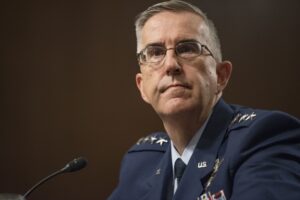The Pentagon’s Joint Requirements Oversight Council in early July published requirements for the four strategic directives – contested logistics, joint fires, Joint All Domain Command and Control (JADC2) and information advantage – driving each of the service branches’ individual contributions to the department’s new Joint Warfighting Concept (JWC).
Air Force Gen. John Hyten, vice chairman of the joint chiefs of staff and head of the JROC, said Monday the strategic directive requirements will help further JWC’s new emphasis on “Expanded Maneuver” following a wargame exercise last October that showed the new operational concept “failing miserably.”

“Without overstating the issue, it failed miserably. An aggressive red team that had been studying the United States for the last 20 years just ran rings around us and they knew exactly what we were going to do before we did it,” Hyten said during an event at the launch of the National Defense Industrial Association’s new Emerging Technologies Institute. “It’s [now about] expanded maneuver in space and time. In every area that an adversary could move, you have to figure out how to fill that space in time before they can move. And you talk about that in all domains, in all commands. You talk about that in all elements of warfare.”
Hyten said finalizing the requirements for each of the four strategic directives will help ensure each of the services factors in priorities for data sharing as they build new platforms, while helping to meet a goal for aggregating capabilities to provide effects while disaggregating to have systems survivable in all threat environments.
“We actually have not done that, really, for a long time, maybe ever. We always aggregate to fight and aggregate to survive. But in today’s world, with hypersonic missiles and significant long-range fires coming at us from all domains, if you’re aggregated and everybody knows where you are, you’re vulnerable,” Hyten said.
Hyten called contested logistics “a difficult problem to solve,” one the U.S. likely has not had to deal with since World War II, and said pushing for aggregated joint fires is an “aspirational requirement” to get after effects from “all domains and all services with no restrictions.”
“That’s purely an aspirational requirement but I hope everybody can see that if you could do that you would change the equation on any future battlefield. Now you have to figure out what is affordable, what is practical, what can you do, where can you bring it from, who can have it. All those things you have to work out, but you should never limit yourself because you begin a concept with what you don’t think you can do,” Hyten said.
Last month, Hyten said he sees information advantage as uniting all four JWC pillars with artificial intelligence serving as the key enabler required to meet the “speed of decision making and processing and the sheer mass of information across logistics, fires, command and control” (Defense Daily, June 24).